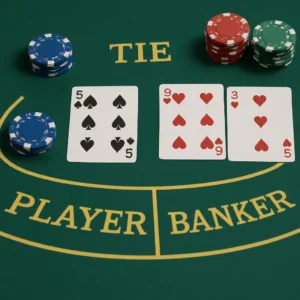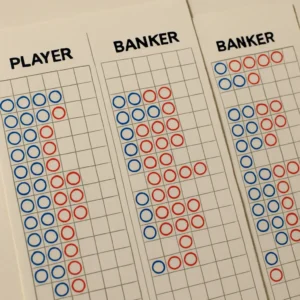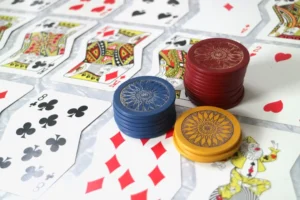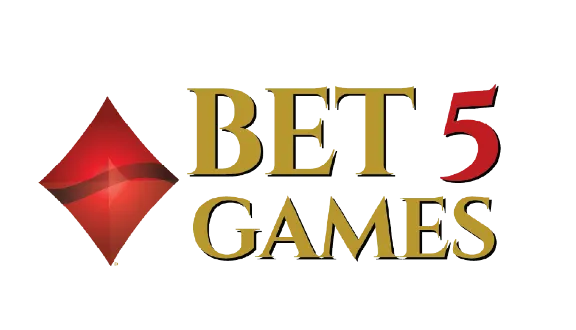Published on September 17, 2025
Author : Bet5Games Editorial Team
For many baccarat players, the elegant simplicity of the game is its main appeal. You bet on Player, Banker, or Tie, and the cards do the rest. But for those who play professionally or simply want a deeper strategic edge, the game is also a puzzle of patterns, trends, and streaks. The secret to unlocking these lies in the scoreboards, and no single tool is more valuable for this than the Big Eye Boy road.
This isn’t just another rulebook. As an experienced player, I’m going to walk you through the logic behind this powerful tool, so you can stop being overwhelmed by the charts and start using them to inform your betting decisions.
What is Big Eye Boy in Baccarat?

Big Eye Boy is one of the “derived roads” in baccarat. Think of it as a secondary scoreboard that doesn’t track the actual outcome of each hand (Player, Banker, or Tie) directly. Instead, it tracks the patterns of the game. Its purpose is to tell you if the shoe is following a predictable trend or if it’s “choppy” and random.
The name, which might sound a little strange, is a nod to its function: it’s like a “third eye” that sees the hidden patterns in the game’s flow. It’s not a crystal ball, but it’s the next best thing for a serious player.
The Core Logic: How Big Eye Boy is Recorded
To understand Big Eye Boy, you first need to understand the Big Road, which is the primary scoreboard that tracks every Player and Banker win. The Big Road shows a new column for every change in the winning side. For instance, a streak of three Banker wins followed by two Player wins would appear as a column of three red circles and then a new column with two blue circles.
Big Eye Boy’s entries are a response to this primary road. It uses hollow red circles and hollow blue circles to represent the presence or absence of a pattern.
A red circle signifies a repeating pattern. The shoe is “doing what it did before.”
A blue circle signifies a “choppy” or random pattern. The shoe is “not doing what it did before.”
This is the most crucial distinction to remember: red is good for trend followers, blue is good for players who bet on alternation.
The Starting Point
Big Eye Boy doesn’t start recording from the very first hand. It needs enough data to make a comparison. The first entry in Big Eye Boy is marked after the hand that completes the first entry in the second column of the Big Road. This ensures there are at least two columns of data to compare.
The Two Golden Rules
The logic for marking Big Eye Boy can seem complicated, but it all boils down to two simple questions you ask yourself about the Big Road.
Rule 1: Is the new hand starting a new column on the Big Road?
If a new column is being formed (meaning the winning side has just changed from Player to Banker or vice versa), you compare the previous two columns on the Big Road.
If the two columns are the same depth (e.g., both columns have 3 circles), you mark a red circle on the Big Eye Boy. The pattern is repeating.
If the two columns are a different depth (e.g., one has 3 circles, the other has 4), you mark a blue circle. The pattern is not repeating.
Rule 2: Is the new hand continuing an existing streak?
If the new hand is in the same column as the previous one, you’re not starting a new column. Instead, you compare the cell that is one step to the left of the new entry and the cell directly above that one.
If these two cells are the same color (both red or both blue), or if they are both empty, you mark a red circle in Big Eye Boy. The pattern of a continuous streak is repeating.
If the two cells are different colors (one red, one blue), you mark a blue circle. The pattern of a continuous streak is breaking.
Why doesn’t Big Eye Boy record ties? Ties don’t affect the streaks between Player and Banker wins, so they are ignored by the derived roads.
A Step-by-Step Example of Big Eye Boy in Action

Let’s imagine a portion of a Big Road:
Column 1: Banker (B), B, B, B
Column 2: Player (P), P
Column 3: Banker (B), B, B
Column 4: Player (P), P, P
Column 5: Banker (B)
Now let’s apply our rules to mark the Big Eye Boy road:
After the first P in Column 2: This is our starting point. We check the depths of Column 1 (4) and Column 2 (1). They are different. Mark a blue circle.
After the second P in Column 2: The streak is continuing. We look at the Big Road: the cell to the left of our new P is blank. The cell above that is also blank. Same. Mark a red circle.
After the first B in Column 3: This is a new column. We compare Column 2 (depth 2) and Column 3 (depth 1). They are different. Mark a blue circle.
After the second B in Column 3: The streak is continuing. On the Big Road, the cell to the left of this B is a P. The cell above it is blank. Different. Mark a blue circle.
After the third B in Column 3: The streak is continuing. On the Big Road, the cell to the left is P. The cell above is blank. Different. Mark a blue circle.
You can see how a simple, choppy pattern on the Big Road (B-P-B) leads to a string of blue circles. If the Big Road started a streak of B,B,B, then P,P,P, the Big Eye Boy would have shown a string of red circles because the column depths (3 vs 3) would match. This is how it tracks patterns.
Using Big Eye Boy for Your Betting Strategy
This is where the rubber meets the road. Knowing what the symbols mean is one thing; using them to inform your bets is another.
The Red Circle Streak
When you see a string of red circles on the Big Eye Boy, the shoe is in a “trending” phase. This means it’s likely to do what it has done before. Common patterns include:
Repetitive streaks: B,B,B then P,P,P.
Alternating columns: B,B then P,P then B,B.
Long-running streaks: A long Banker or Player streak.
In these situations, your strategy should be to follow the trend. If the Big Road is showing a long streak of Bankers, and Big Eye Boy is red, bet on Banker. If it’s a “ping-pong” pattern (alternating B-P-B-P), and Big Eye Boy is red, bet on the alternation.
The Blue Circle Trend
A string of blue circles indicates a “choppy” or “unpredictable” shoe. The patterns are not repeating, and the results seem more random.
Your strategy here is to be cautious. You might bet on a “chop” (betting on the opposite of the last hand) or, more wisely, reduce your bet size or sit out until a clearer pattern emerges.
Combining Big Eye Boy with Other Roads
To increase your confidence, you can cross-reference with the other derived roads like the Small Road and Cockroach Road. If Big Eye Boy is showing a red streak, and the Small Road and Cockroach Road are also showing red, you have strong confirmation that a stable pattern exists.
Common Pitfalls and Strategic Nuances
The Dragon Tail
A “dragon tail” is a streak that goes off the bottom of the Big Road grid. For the purpose of Big Eye Boy, you simply continue to apply the rules as if the grid were infinitely deep, comparing the cell to the left with the one above it. The rule remains the same: same cells = red, different cells = blue.
How to Distinguish a Stable Pattern?
A stable pattern is signified by a long, uninterrupted streak of red circles in Big Eye Boy. A trend break is when a blue circle appears in the middle of a red streak. This is a clear signal to re-evaluate your strategy and possibly stop betting on the current pattern.
How Reliable is Big Eye Boy Analysis?
Big Eye Boy is a tool for pattern recognition, not a predictor of future events. It’s built on a logical formula, so the patterns it shows are always correct based on the rules. However, it’s crucial to remember that baccarat is a game of chance. The odds of the next hand are always the same. Big Eye Boy simply helps you identify if the past results fit a common pattern, which many players believe is a sign of what the future may hold. It does not improve your winning odds in a mathematical sense, but it helps you make more informed and strategic bets based on the shoe’s history.
FAQs from the Baccarat Table
How is a new column marked? A new column is marked on the Big Road when the winning side changes (from Banker to Player or vice versa).
What does “same depth” mean? It refers to two consecutive columns on the Big Road having the same number of entries (e.g., both columns have 3 wins).
What is compared if the hand is in the same column? You compare the cell to the left of the new entry with the cell directly above that one.
Can it guide bet sizes? Yes. Many players will increase their bet size when a strong, red-circle pattern emerges and decrease it or stop betting when the road turns “blue” or chaotic.
Are there common mistakes with Big Eye Boy? The biggest mistake is treating it as a prophecy. It’s a tool for analysis, not a guarantee. Another mistake is not knowing the rules and marking it incorrectly.
The Filipino Connection: Why Big Eye Boy is So Popular
The use of baccarat roads is extremely popular in Asian casinos, particularly in the Philippines. Filipino players, known for their love of strategic gambling, have embraced these tools as a core part of their game. They often spend hours meticulously tracking the shoes, believing that a careful analysis of the roads provides an edge. This local popularity has helped spread the use of Big Eye Boy and other roads to casinos and online platforms worldwide, making it a staple of serious baccarat play.
Final Thoughts: Use the Road, Don’t Let it Use You
The Big Eye Boy road is an invaluable tool for any baccarat player who wants to move beyond pure luck. By understanding the simple, logical rules behind it, you can make smarter, more confident bets. It allows you to feel the pulse of the shoe and identify trends, giving you a sense of control in a game of chance. Remember to treat it as a guide, not a foolproof system, and you’ll be on your way to a more enjoyable and strategic baccarat experience.

